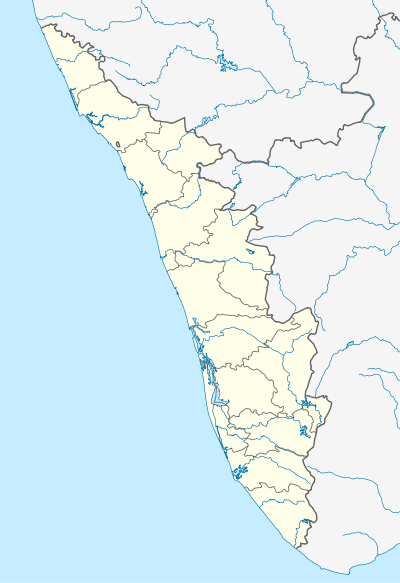Pattanam
| Pattanam | |
|---|---|
| Village | |
 Pattanam  Pattanam Location in Kerala, India | |
| Coordinates: 10°09′24″N 76°12′32″E / 10.15654°N 76.208982°ECoordinates: 10°09′24″N 76°12′32″E / 10.15654°N 76.208982°E | |
| Country |
|
| State | Kerala |
| District | Ernakulam |
| Government | |
| • Body | Chittattukara Panchayat |
| Languages | |
| • Official | Malayalam, English |
| Time zone | IST (UTC+5:30) |
| PIN | 683 522 |
| Telephone code | 0484 |
| Vehicle registration | KL-42 |
| Nearest city | Kochi |
| Lok Sabha constituency | Ernakulam |
| Civic agency | Chittattukara Panchayat |
| Climate | tropical (Köppen) |
Pattanam (Malayalam: പട്ടണം) is a village located in the Periyar delta in Eranakulam district in the southern Indian state of Kerala. It is located 2 km north of North Paravur, 9 km south of Kodungallur (Cranganore) and 25 km north of Kochi (Cochin).
According to the recent archaeological excavations, Pattanam seems to have been first occupied by an indigenous population around 1000 BC and continued to be active till the 10th century AD.[1] Some archaeologists identify it as the ancient Muziris.
The nearby site of Kottapuram was also excavated as part of the Muziris Heritage Project.
History
A branch of the Periyar river, called the Periyar Thodu (Periyar canal), runs close to Pattanam. Satellite imagery, a clear geological evidence, indicated that the Periyar river delta lies on the southern side and the river could have flowed close to Pattanam. Moreover, the residents of Pattanam regularly used to find a large amount of broken pottery shards and ancient fired bricks while digging the ground. These evidences indicate that the Periyar river could have flowed close to Pattanam about 2,000 years ago.[2]
Archaeological excavations
The site for archaeological research at Pattanam (10°09.434’N; 76°12.587’E) covers about 45 hectares. Due to habitation activities it is a “disturbed” site; some parts are partially destroyed due to sand quarrying. The site seems to have been first occupied by indigenous population around 1000 BC and continued to be active till the 10th century AD. The AMS 14C analysis of the charcoal and wood samples from the Iron Age layer and wharf contexts have determined their antiquity as first millennium BC.[3]
The multi-disciplinary and multi-seasonal archaeological research at Pattanam from 2007 undertaken by the Kerala Council for Historical Research (KCHR) is a pioneering initiative in the history of Kerala Archaeology. British Academy (BASAS) recently accorded recognition for the formation of an international research group based on Pattanam.[4]
Square copper coins (on one side an elephant and on the other bows and arrows) had been found at the site. These types of coins were issued in the beginning of Christian era. At the same time there is lack of evidence to show that the artifacts unearthed at Pattanam came specifically from Rome. It is necessary to get information that these are connected directly to Italy.[5]
Excavated antiquities include Chera coins, Amphora, Terra Sigillatta, Cameo Blanks made of semi-precious stones and stone and glass beads in large quantity. Remains of brick structures made of burned bricks were also found there. A wharf context with a six m dugout canoe made of anjili wood and bollards made of teak wood and a large quantity of botanical remains were found.
Excavations 2010
Findings: Antiquities of small size - beads of both semi-precious stones and glass, pendants or lockets [6] cameo blanks, coins, (predominantly early Chera coins, with symbols of elephant, bow and arrow) objects or fragments of objects made of iron, copper, lead and rarely gold, and sherds of Indian and foreign pottery. A broken rim with Brahmi script. This is the first pre-firing pottery inscription finding at Pattanam. Enormous quantity of local pottery of the early Historic Period, which is dated between first century BC and fourth century AD, showing that this was the peak activity stage of Pattanam.
Excavations 2011
The excavations at Pattanam sheds new light on the life and times of the ancient Kerala. The finds this year include iron and copper nails, Roman glass, Chola coins, terracotta and semi precious stone beads.[7]
Archaeology and criticism
Former Director of the Tamil Nadu State Archaeology Department R. Nagaswamy is of opinion that it is not yet time to identify Pattanam as Muziris. [[paravur ]] also is to be excavated before coming to a conclusion. Archaeology requires a lot of evidence before arriving at any conclusion.[5] Romila Thapar has expressed her reservations on the use of ancient DNA sampling techniques, raising doubts whether there was the danger of bacterial contaminations or mutations in samples taken from skeletons that were buried for over 2,000 years. She however describes Pattanam as "a turning point for studies into India’s maritime relations."[8]
See also
- List of archaeological sites by country
- North Paravur
- Thiruvanchikulam
- Ernakulam District
- Paravur Taluk
- Kochi
- Kodungallur
References
- ↑ "National : Pattanam richest Indo-Roman site on Indian Ocean rim". The Hindu. 2009-05-03. Retrieved 2011-09-19.
- ↑ Archaeologists stumble upon Muziris
- ↑ Cherian, P. J. ; Prasad, G. V. Ravi ; Dutta, Koushik ; Ray, Dinesh Kr. ; Selvakumar, V. ; Shajan, K. P., "Chronology of Pattanam: a multi-cultural port site on the Malabar coast", Current Science 97(2), 236-40.
- ↑ http://www.basas.org.uk/groups/ports.htm (http://www.hindu.com/2009/03/20/stories/2009032054890700.htm http://www.kchr.ac.in/
- 1 2 The Hindu (Thiruvananthapuram edition) Friday August 5, 2011, Page 9
- ↑ link http://www.thehindu.com/features/friday-review/history-and-culture/article244338.ece)
- ↑ "Kerala / Kochi News : Pattanam finds throw more light on trade". The Hindu. 2011-06-12. Retrieved 2011-09-19.
- ↑ "Pattanam throws open many questions: Romila Thapar"
Resources
- BBC report, Search for India's ancient city
- Pattanam Excavations (Comprehensive Resource)
- Pattanam excavation significant